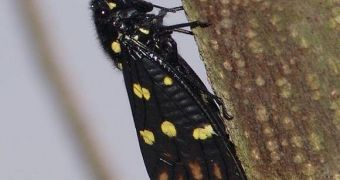Cicadas, which are relatively harmless insects, are also some of the most bizarre in the world. They live either 13 or 17 years, to the minute, and do not come out of the ground for about 99 percent of their life span. But when they do, they come out all at once, with as much as 40,000 of them emerging from under a single tree. Because they have such an erratic lifestyle, researchers find it difficult to study them. But experts in Japan have managed to propose in the May 18th issue of the journal Proceedings of the National Academy of Science a theory of why the insects are able to time their deaths so accurately.
One of the possible explanations could be that evolution has hardwired them to avoid interbreeding. That is to say, if the species living 13 years mated with species living 17, then there would be a good chance that the offspring would have an intermediary life span, such as 15 years. This would mean that they would emerge from the ground two years before and after the bulk of their fellow cicadas, and thus be more exposed to danger. However, it's still unclear if interbreeding would produce such effects, as studies on the matter have been scarce, on account of the long time-frames involved.
The thing that fascinated researchers most since the animals were discovered was the fact that their life spans were prime numbers, divisible only by themselves and the number 1, Wired reports. And another interesting feat was that the numbers were higher than, say, five and seven. If that were the case, the two classes of species would have synced up every 35 years.
But, as they live 13 and 17 years, respectively, they only come out at the same time every 221 years. In addition, their long lives mean that they elude the life cycles of most of their predators, which live three to five years. Thus, they only encounter predators once every decade or so, which can be looked at as a natural regulatory mechanism, to prevent them from spreading uncontrollably.
“Our hypothesis is that cicada emergences minimize overlap with the periodic cycles of their predators, like birds and small animals, which are 2 to 5 years. By choosing prime number, through evolution, cicadas avoid meshing with these shorter cycles,” Vanderbilt University Mathemetician Glenn Webb said. “Their life cycles have been suspicious since the beginning. It’s a surprising and unique combination of a long life cycle and mass emergence. And on top of that, why do they have to be prime? [This study] ties that all together,” research collaborator John Cooley, who has worked on the new investigation together with colleagues from the Shizuoka University in Japan, led by Jin Yoshimura, added.

 14 DAY TRIAL //
14 DAY TRIAL //